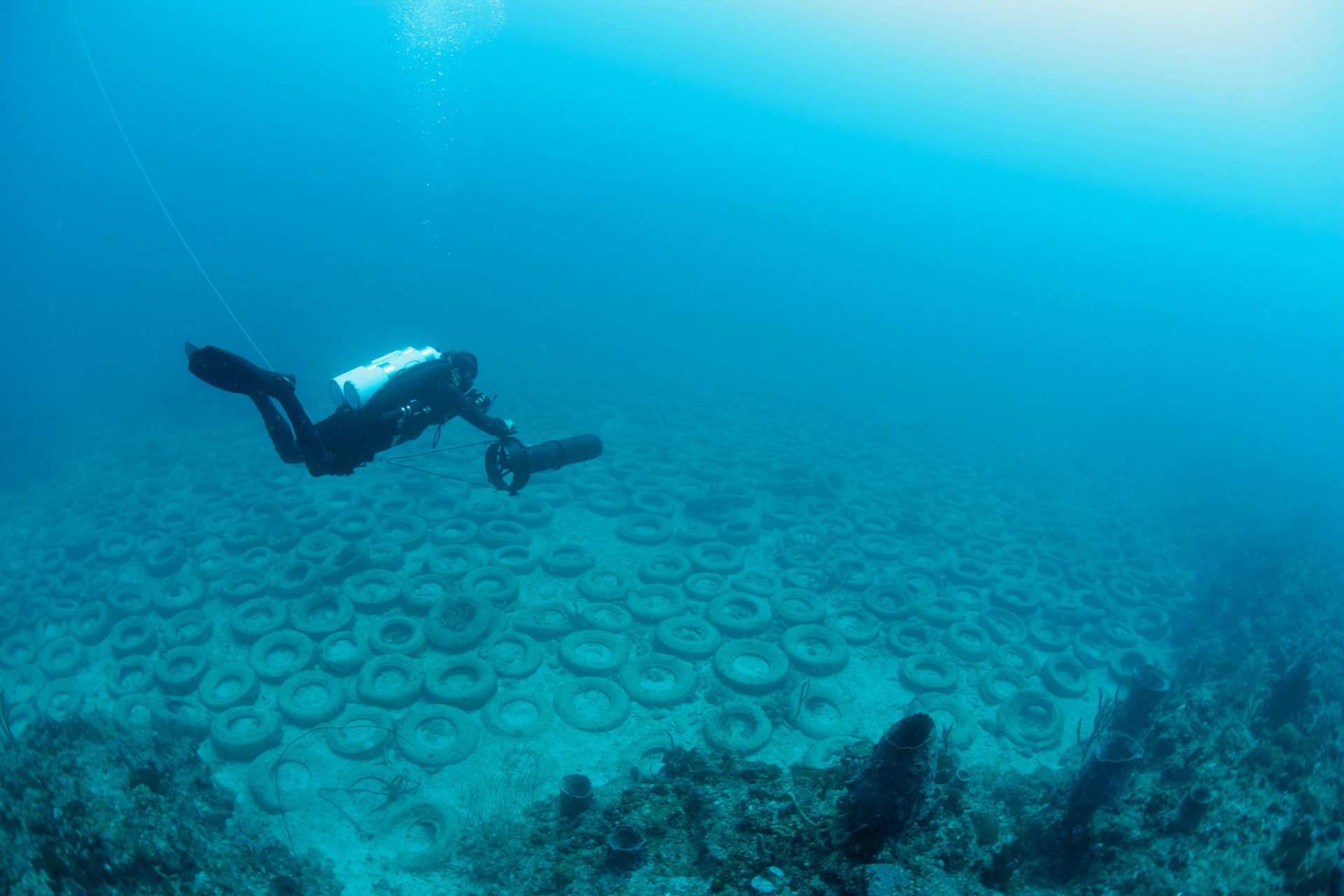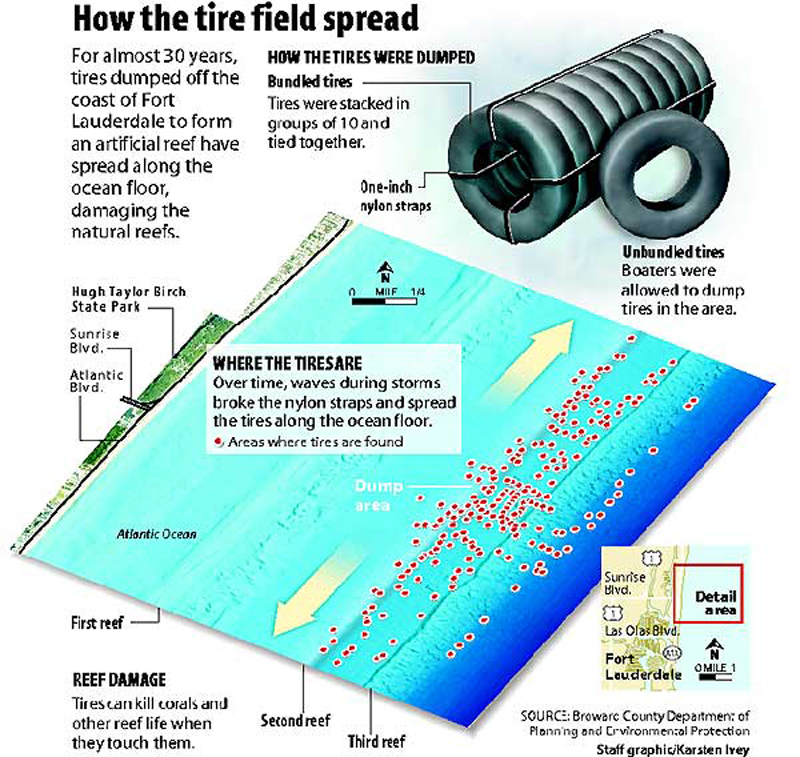
The Osborne Tire Reef
Where and What
The Osborne Tire Reef is an artificial reef off about 7,000 feet offshore of Sunrise Boulevard off the coast of Fort Lauderdale, Florida constructed of concrete jacks in a 50 feet (15m) diameter circle. In the 1970s, the reef was subject to an ambitious expansion project utilizing old and discarded tires.
Background
In the 1960s, before recycling caught on, used tires were piling up at an alarming rate. Illegal dumps arose in rural areas. Some caught fire. Many became spawning grounds for mosquitoes.
Meanwhile, fishing captains were looking for materials to build artificial reefs – structures that would attract fish and other marine life by providing hiding places and hard surfaces. Tire reefs appeared to be the answer. Hoping to establish better fish habitat, Florida, Texas, Virginia, North Carolina and several other states dumped millions of used tires into the ocean.
So in the early 1970s, a group of fishermen decided to create a reef of tires off Hugh Taylor Birch State Park. Suggesting to enlarge the reef using old discarded tires as a way to dispose of them, but also to lure more game fish to the area, Broward Artificial Reef Inc. (BARINC) put forward the proposition and Broward County endorsed the project, as did Fort Lauderdale and various state and federal agencies. Goodyear Tire & Rubber Co. agreed to provide equipment.
Citing Wikipedia: With endorsement of the project by the US Army Corps of Engineers, the Broward County government approved the project: that spring more than 100 privately owned boats enthusiastically volunteered to assist with the project; accompanied by the USS Thrush thousands of tire bundles were simultaneously dropped onto the reef. The Goodyear Tire and Rubber Company provided equipment for the auspicious undertaking; even supporting the project so far as to drop a gold-painted tire from a Goodyear Blimp to christen the site. The culmination of the project was the deposit of over two million tires bound with steel clips over 36 acres (150,000 m2) of the ocean floor, approximately 7,000 feet (2,100 m) offshore and at a depth of 65 feet (20 m).

Barge used to deploy discarded tires in building the Osborne Tire Reef off the coast of Fort Lauderdale Florida
The project ultimately failed, and the “reef” has come to be considered an environmental disaster. It was speculated that corals would attach and grow on the tires, but it is evidently clear today that this has hardly happened. One reason that this never materialized has been that the tires were too mobile, shifting around if not completely migrating. Many of the tires were originally tied together with nylon or steel clips or bands, while a lot of tires simply were dumped as loose entities. Those that were tied together suffered from ties corroding away or breaking essentially resulting in all tires more or less being loose and mobile.

Tires bundled up before deployment

This mobility essentially destroyed whatever growth had attached to the tires and prevented any new formation and growth of organisms.
Storms and hurricanes frequent the area every year and whenever they come, there’s great risk of tires being shifted around and migrating even more. In 1995, Hurricane Opal spread over 1,000 of the tires onto the Florida Panhandle, west of Pensacola; and in 1998, Hurricane Bonnie deposited thousands of the tires onto North Carolina beaches thus not confining the problem to the Osborne Reef area.
What was meant to do good for nature is causing more harm.
Clean Up and Retrieval
There has been several commencement efforts to clean up the tire reef and removing them, but most of them never really materialized.
The biggest project was in 2007 when the United States military used the site and carried out some retrieval of tires as part of real-world training for their diving and recovery personnel while at the same time benefiting the Florida coast. The military, according to Wikipedia, retrieved 53,900 tires over 2007 and 2008.
Before that, in 2001 Dr. Robin Sherman of Nova Southeastern University was awarded a grant from the National Oceanic and Atmospheric Administration to begin a tire removal program, but only managed to remove 1,600 tires.
Subsequent efforts in 2009 that included army and navy divers have brought the amount of recovered tires to approximately 73,000 tires from the reef.
Still Need A Solution
Remaining a huge problem, a great number of the tires continue migrating across the sandy bottom, over and onto the natural reef causing great damage there.
State and county environmental officials are still trying to find ways to haul the tires back up – a difficult and expensive endeavor, but one that is necessary to protect the existing reefs.
Project Baseline Gulfstream is exploring means and best avenues of tire removal procedures and are monitoring the status quo and further development. This is a huge project and undertaking, but we are keen on making a real difference and see if we can be part of a solution for remedying the problem.
Similar Problems Elsewhere
Similar reefs have been constructed in the Northeastern Unites States, the neighboring Gulf of Mexico, Indonesia, Malaysia, Australia and Africa. Quoting Jack Sobel, a senior Ocean Conservancy scientist, in an article from International Herald Tribune from February 18th 2007, “Indonesia and Malaysia mounted enormous tire-reef programs in the 1980s and are now seeing the ramifications, from littered beaches to reef destruction”.
If Project Baseline Gulfstream proves successful with their participation in the Osborne Tire Reef clean-up, the methods and techniques could be utilized elsewhere. Project Baseline is a Global Initiative, so it also makes a lot of sense that our efforts and part focus would go to similar problems located around the globe.
| There weren’t supposed to be any tires here… Read the shocking report from one of the other dives Project Baseline Gulfstream did to document the out reef… |



